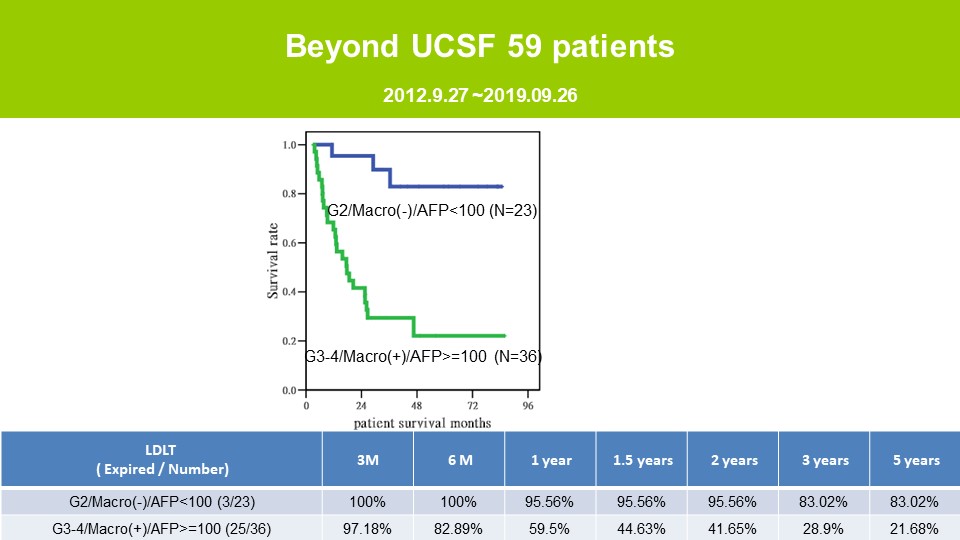Living Donor Liver Transplantation for Hepatocellular Carcinoma Beyond UCSF Criteria: Tumor Biology Not the Tumor Number Decide the Long Term Outcome- A Single Center Retrospective Analysis of Using Extended Criteria
A. Thorat, L. Jeng, S. Hsu, H. Yang, P. Li, T. Chen, K. Poon
Organ Transplantation Center, China Medical University Hospital, Taichung, Taiwan
Meeting: 2020 American Transplant Congress
Abstract number: A-152
Keywords: Hepatocellular carcinoma, Living-related liver donors, Tumor recurrence
Session Information
Session Name: Poster Session A: Liver: Hepatocellular Carcinoma and Other Malignancies
Session Type: Poster Session
Date: Saturday, May 30, 2020
Session Time: 3:15pm-4:00pm
 Presentation Time: 3:30pm-4:00pm
Presentation Time: 3:30pm-4:00pm
Location: Virtual
*Purpose: HCC is the fifth most common cancer and the third most frequent cause of cancer deaths worldwide. After its introduction for LT in HCC patients, Milan’s criteria were universally validated and, also, was accepted as allocation criteria of UNOS in 2001 & Eurotransplantation in 2006. However, due to restrictive nature of the Milan’s criteria and ever-increasing HCC patient cohort, UCSF criteria was introduced which was first modest attempt to expand the criteria. In this study, we present our experience of LDLT for HCC patients beyond the UCSF criteria.
*Methods: From September 2002 to August 2019, a total of 1054 LDLT surgeries were performed at China Medical University Hospital, Taiwan. Database of the 469 patients of HCC that underwent LDLT was analysed and patients with HCC beyond the UCSF criteria were (n=147) were further studied for long-term outcome. 56 patients with AFP levels < 1000 ng/ml were further studied for the histopoatholgical characteristics. The patients were further categorized as per the degree of differentiation of the tumor on histopathological examination (HPE), vascular invasion and AFP levels- Group A (G1-G2/Macro(-)/AFP<100) and Group B (G3-G4/Macro(+)/AFP>100)
*Results: 147 patients (31.3%) had the HCC beyond the criteria whereas 322 patients (68.7%) were within UCSF criteria. 5-overall survival achieved in patients beyond UCSF was 45.7% versus 74.65% 5-year survival for patients within UCSF criteria. The study cohort was further categorized depending upon the degree of differentiation of HCC. 5-year survival for Group A HCC patients was 83% whereas the outcome was inferior in Group HCC patients with a 5-year survival rate of 21.68% (Figure 1). Patients with AFP >1000 ng/ml showed a dismal prognosis with a 5-year survival of < 21% patients.
*Conclusions: Extended criteria for HCC in LDLT can achieve a modest long-term survival. Features of biological tumor behavior, such as tumor grading and vascular invasion and high AFP levels have impact on recurrence of HCC after LDLT. Tumors with well differentiated morphology and AFP levels <100 ng/ml increases long-term survival even further.
To cite this abstract in AMA style:
Thorat A, Jeng L, Hsu S, Yang H, Li P, Chen T, Poon K. Living Donor Liver Transplantation for Hepatocellular Carcinoma Beyond UCSF Criteria: Tumor Biology Not the Tumor Number Decide the Long Term Outcome- A Single Center Retrospective Analysis of Using Extended Criteria [abstract]. Am J Transplant. 2020; 20 (suppl 3). https://atcmeetingabstracts.com/abstract/living-donor-liver-transplantation-for-hepatocellular-carcinoma-beyond-ucsf-criteria-tumor-biology-not-the-tumor-number-decide-the-long-term-outcome-a-single-center-retrospective-analysis-of-using-e/. Accessed December 5, 2025.« Back to 2020 American Transplant Congress

